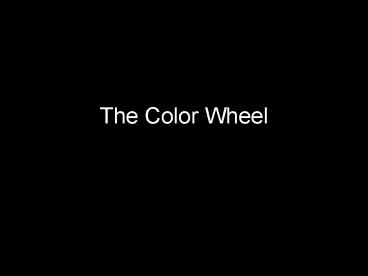The Color Wheel - PowerPoint PPT Presentation
1 / 42
Title:
The Color Wheel
Description:
Sir Isaac Newton developed the first circular diagram of colors in 1666. Color wheel ... in the ancient technique of fresco, Frankenthaler's technique fused paint and ... – PowerPoint PPT presentation
Number of Views:61
Avg rating:3.0/5.0
Title: The Color Wheel
1
The Color Wheel
2
History
- A color circle, based on red, yellow and blue, is
traditional in the field of art. Sir Isaac Newton
developed the first circular diagram of colors in
1666.
3
Color wheel
- Primary
- Red, Yellow, Blue
- Secondary
- Tertiary/Intermediate
4
- Franz Marc
- The Blue Horse
5
The meaning of color
- Franz Marc believed that each color had a
specific meaning. - - from Franz Marcs journal
- Blue - masculine, strength, youth, vitality
- Red - violence, power
- Yellow - feminine, light, favoring green and blue
- Green - feminine, jealousy, anger
- Violet - pure, forgiving
- Orange - earth, sun, warmth
6
Other types of symbolism refer to nature
- Blue sky, calming, water, soothing
- Green vegetation, life, fertility
- Red fire, blood, violence
- Etc.
7
Art and Design
- In visual experiences, harmony is something that
is pleasing to the eye. It engages the viewer and
it creates an inner sense of order, a balance in
the visual experience.
8
Color Theory
- In traditional color theory, these are the 3
pigment colors that can not be mixed or formed by
any combination of other colors. All other colors
are derived from these 3 hues
9
Color Theory
- Studying, analyzing and using color in a specific
way is how we will apply color theory. - You goal will be to use color to create
interesting and dynamic artwork and compositions.
10
(No Transcript)
11
Mark Rothko
- is known for his abstract artwork described as
fields of color. His style is somewhat loose and
his forms are very similar, his work often
creates a color environment for the viewer. - Mark Rothko is an immigrated from Russia in 1913
and studied at Yale university from 1921 1923
Rothko died in 1970
12
(No Transcript)
13
Color field art
- This type of artwork gained popularity in the
1960s and still continues to develop today. - It is based on using color as a non-objective
form of expression pure color.
14
(No Transcript)
15
About Rothko
- Rothko's abstractions were deeply personal
statements that sought to provide a
transcendental experience he described his work
as the "simple expression of complex thought."
The late 1950s brought increasing recognition of
his work along with several commissions for
murals.
16
(No Transcript)
17
Helen Frankenthaler
- Color Field Artist
18
(No Transcript)
19
About Helens Work
- Working on the floor of her New York studio,
Frankenthaler devised a unique technique using
oil paint thinned to a watery consistency and
alternately pouring and dripping the paint onto
an unsized, unprimed canvas. As paint and plaster
become one in the ancient technique of fresco,
Frankenthaler's technique fused paint and canvas
into a single entity. The works evoke strong
feelings of emotion and are often displayed in
reverent, quiet and reflective locations.
20
(No Transcript)
21
(No Transcript)
22
Color Field painting
- Helens work gained popularity in 1952 and color
field and abstract art continued to develop
through the 1960s and 70s. - There are also many contemporary abstract and
color field artists practicing today.
23
(No Transcript)
24
(No Transcript)
25
(No Transcript)
26
(No Transcript)
27
(No Transcript)
28
(No Transcript)
29
(No Transcript)
30
Terms and Definitions
- Take notes in your sketchbook
31
Primary Colors
- Primary - these are colors that cannot be mixed
Red, Yellow, and Blue - These are the most important colors on the color
wheel
32
Secondary
- Secondary - Orange Green, and Violet
- - these colors are mixed by adding two primary
colors together. Ex, yellow and red make orange
33
Tertiary or Intermediate
- Tertiary - Red-orange, yellow-orange,
yellow-green, blue-green, blue-violet,
red-violet - when naming these colors the primary color comes
before the secondary color. (the name also tells
you how to mix it)
34
Neutrals
- Neutrals - these hues are not part of the color
wheel but if certain colors are mixed together
you can create a neutral. Ex. Red and green make
brown - Black, White, Grey, Brown, and Tan
35
Monochromatic
- Monochromatic - this means that you add black or
white to a color to make a shade or a tint.
(lighter or darker)
36
Analogous
- Analogous - colors that are adjacent (next to)
each other on the color wheel.
37
Warm
- Warm - colors like red, orange, or yellow might
symbolize something being hot.
38
Cool
- Cool - colors like green, blue, or violet might
symbolize something being cold.
39
Tint
- Tint - this is what you get when you add white to
a color.
40
Shade
- Shade - this is what you get when you add black
to a color.
41
Complement
- Complements - these colors are opposite each
other on the color wheel. Ex. Red and Green, Blue
and Orange, Yellow and Violet, etc
42
(No Transcript)































